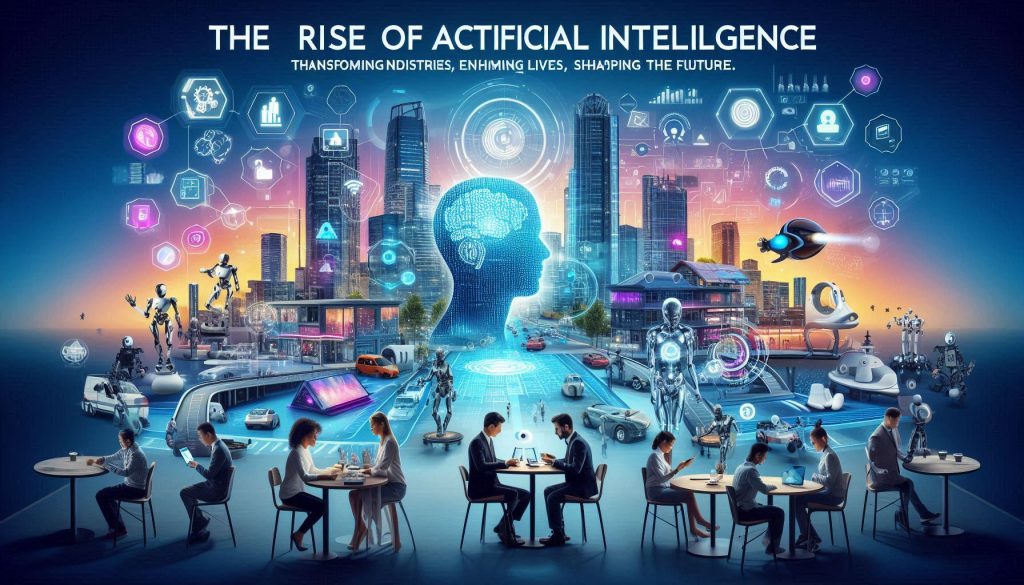The advent of artificial intelligence marks a pivotal moment in human history. With its ability to process vast amounts of data, learn from patterns, and make decisions, AI is propelling us into a new era of innovation and efficiency. This article delves into how AI is seamlessly integrating into everyday life, its impact on various industries, and the potential it holds for the future. As AI continues to evolve, its transformative power raises questions and opportunities that warrant deeper exploration.

2. Understanding Artificial Intelligence
2.1 Definition and Core Concepts
Artificial Intelligence refers to the simulation of human intelligence in machines programmed to think like humans and mimic their actions. It encompasses various subfields, including machine learning (where algorithms learn from data), natural language processing (enabling machines to understand and respond to human language), computer vision (allowing machines to interpret visual information), and robotics (the design and use of robots for various tasks). Understanding these concepts is crucial for grasping the full impact of AI on our society.
2.2 Types of AI: Narrow vs. General
- Narrow AI (Weak AI): Designed to perform specific tasks, such as voice recognition or data analysis. Most AI applications today, including chatbots and recommendation systems, fall under this category. They excel in their designated tasks but lack general cognitive abilities.
- General AI (Strong AI): A theoretical form of AI where machines possess the ability to understand, learn, and apply knowledge in a generalized way, similar to a human being. While general AI remains largely a concept, its potential implications for society are profound, prompting discussions on ethics and control.

3. AI’s Impact on Key Industries
3.1 Healthcare
AI is transforming healthcare by enhancing diagnostic accuracy, personalizing treatments, and improving patient outcomes. It facilitates advanced research methodologies, allowing for quicker and more effective responses to health crises.
- Medical Imaging: AI algorithms can detect anomalies in X-rays, MRIs, and CT scans with high precision, often outperforming human radiologists.
- Drug Discovery: AI accelerates the drug development process by predicting molecular structures and potential outcomes, reducing the time and cost associated with bringing new medications to market.
- Telemedicine: AI-powered platforms enable remote patient monitoring and virtual consultations, expanding access to care, especially in underserved regions.
3.2 Manufacturing
AI optimizes production processes, reduces costs, and enhances quality control in manufacturing.
- Predictive Maintenance: Sensors and AI analytics predict equipment failures before they occur, minimizing downtime and extending machinery lifespan.
- Robotics Automation: AI-driven robots handle repetitive tasks, increasing efficiency and allowing human workers to focus on complex duties, ultimately leading to improved job satisfaction.
- Supply Chain Optimization: AI improves inventory management and demand forecasting, allowing companies to respond more agilely to market fluctuations.
3.3 Finance
In finance, AI enhances security, customer service, and investment strategies.
- Fraud Detection: AI systems identify unusual transactions, using machine learning to continuously improve their detection capabilities, which is critical in a rapidly evolving financial landscape.
- Customer Service: Chatbots provide instant support, improving customer satisfaction by handling inquiries 24/7 and reducing wait times.
- Algorithmic Trading: AI analyzes market trends to execute trades at optimal times, leveraging vast amounts of financial data for better investment outcomes.
3.4 Retail and E-commerce
AI personalizes the shopping experience and streamlines operations in retail.
- Recommendation Engines: AI suggests products based on consumer behavior, utilizing advanced algorithms to increase sales and enhance customer satisfaction.
- Inventory Management: Predictive analytics optimize stock levels, reducing costs and ensuring that popular products are always available.
- Virtual Assistants: AI chatbots aid customers during the shopping process, providing personalized assistance that enhances the shopping experience.
3.5 Transportation
AI is paving the way for safer and more efficient transportation.
- Autonomous Vehicles: Self-driving cars use AI to navigate and respond to environments, potentially reducing accidents caused by human error.
- Traffic Management: AI optimizes traffic flow, reducing congestion and improving urban mobility through intelligent traffic signal control and route optimization.
- Logistics: AI enhances route planning for delivery services, increasing efficiency and reducing fuel consumption.
3.6 Agriculture
AI contributes to sustainable farming and increased productivity.
- Precision Farming: AI analyzes soil and crop data to optimize farming practices, ensuring that resources are used efficiently and sustainably.
- Disease Detection: AI identifies plant diseases early, preventing crop losses and ensuring food security.
- Resource Management: AI optimizes water and fertilizer use, contributing to environmental conservation and reducing farming costs.

4. AI in Daily Life
4.1 Smart Homes
Smart home technologies use AI to create more comfortable and efficient living spaces.
- Energy Management: AI adjusts heating and cooling systems based on usage patterns, leading to energy savings and reduced utility bills.
- Security Systems: AI-powered cameras and alarms enhance home security, providing real-time alerts and monitoring.
- Appliance Automation: Devices like smart fridges and ovens adapt to user habits, improving convenience and functionality.
4.2 Virtual Assistants
Virtual assistants like Siri, Alexa, and Google Assistant perform tasks ranging from setting reminders to controlling smart home devices.
- Voice Recognition: AI interprets and responds to natural language commands, making technology more accessible and user-friendly.
- Task Automation: AI manages schedules, emails, and other routine tasks, allowing users to focus on more important activities.
4.3 Personalized Entertainment
AI curates content to individual preferences.
- Streaming Services: Algorithms recommend movies and shows on platforms like Netflix, significantly enhancing user experience and engagement.
- Music Apps: Services like Spotify create personalized playlists based on listening habits, introducing users to new artists and genres.
- Gaming: AI enhances gameplay with adaptive difficulty levels and realistic NPC behaviors, creating more immersive gaming experiences.
4.4 Education and Learning
AI personalizes educational experiences.
- Adaptive Learning Platforms: AI adjusts curriculum based on student performance, tailoring learning to individual needs and promoting better outcomes.
- Virtual Tutors: AI provides assistance outside the classroom, helping students with homework and study techniques.
- Language Learning Apps: AI facilitates language acquisition with interactive exercises, improving fluency and comprehension.

5. Market Trends and Consumer Behavior
5.1 Adoption Rates and Demographics
The adoption of AI technologies is accelerating across all demographics.
- Global Integration: An estimated 80% of emerging technologies will have AI foundations by 2025, indicating a broad acceptance and reliance on AI in various sectors.
- Consumer Acceptance: Increasing familiarity with AI products is reducing barriers to adoption, as consumers recognize the benefits of AI-enhanced solutions.
5.2 Consumer Trust and Privacy Concerns
While consumers embrace AI, concerns about data privacy and security persist.
- Data Protection: 65% of consumers worry about how companies use their data, highlighting the need for transparent practices in AI development.
- Transparency: There is a growing demand for clear information on AI operations, pushing companies to adopt more ethical data practices.
5.3 The Shift Toward AI-Driven Services
Businesses are investing heavily in AI to meet consumer expectations.
- Competitive Advantage: Companies leveraging AI report higher customer satisfaction and loyalty, as AI tools enable personalized services and efficient operations.
- Market Growth: The AI market is projected to reach $190 billion by 2025, driven by advancements in technology and increasing integration across industries.

6. Future Outlook
6.1 Emerging Technologies and Innovations
- Edge AI: Processing data on devices reduces latency and enhances privacy, enabling real-time decision-making without the need for constant internet connectivity.
- AI and IoT Integration: Combining AI with the Internet of Things creates smarter systems that optimize processes and improve user experiences across various sectors.
- Advancements in Natural Language Processing: More sophisticated interactions with machines will make AI-driven applications more intuitive and user-friendly.
6.2 Economic and Employment Implications
- Job Transformation: AI will create new job categories while rendering others obsolete, necessitating workforce reskilling and adaptation to new roles.
- Productivity Increases: AI could double annual economic growth rates in developed economies, enhancing output and innovation.
- Reskilling Workforce: Emphasis on STEM education and continuous learning will be critical in preparing the workforce for the evolving job landscape.
6.3 Ethical Considerations and Regulatory Landscape
- AI Ethics: Ensuring AI operates fairly, transparently, and without bias is essential to maintain public trust and acceptance.
- Regulations: Governments are crafting policies to manage AI’s impact, balancing innovation with the need for consumer protection and ethical standards.
- International Collaboration: Global standards and agreements on AI usage will be necessary to address cross-border challenges and ensure a coordinated approach.

7. Conclusion
Artificial Intelligence is undeniably reshaping the contours of modern life. Its integration into industries and personal spheres offers unprecedented opportunities for efficiency, innovation, and growth. However, this transformation comes with challenges that require careful navigation, including ethical considerations, privacy concerns, and the need for a skilled workforce. As AI continues to evolve, staying informed and adaptable is crucial for businesses and individuals alike. Embracing AI responsibly will unlock its full potential, driving sustainable development and enhanced quality of life globally.
8. Recommendations
For Businesses:
- Invest in AI Research and Development: Stay ahead by exploring AI applications relevant to your industry and fostering innovation within your organization.
- Prioritize Ethics and Transparency: Build consumer trust through ethical AI practices, ensuring that your organization is committed to responsible AI use.
- Upskill Employees: Provide training to prepare your workforce for AI integration, emphasizing the importance of continuous learning and adaptation.
For Consumers:
- Stay Informed: Understand how AI affects your daily life and privacy, empowering yourself to make informed choices.
- Embrace AI Technologies: Leverage AI tools to enhance productivity and convenience, recognizing their value in improving daily tasks.
- Advocate for Responsible AI: Support policies and companies that prioritize ethical AI use, contributing to a more responsible technological landscape.
For Policymakers:
- Develop Clear Regulations: Establish guidelines that promote innovation while protecting citizens, balancing the need for growth with ethical considerations.
- Encourage Collaboration: Foster partnerships between government, industry, and academia to address the challenges and opportunities presented by AI.
- Invest in Education: Support programs that prepare the next generation for an AI-driven world, ensuring a skilled workforce equipped to thrive in the future.
9. References
- Accenture (2020). “Artificial Intelligence is the Future of Growth.” Retrieved from Accenture AI Report
- McKinsey & Company (2021). “The State of AI in 2021.” Retrieved from McKinsey AI Survey
- PwC (2020). “AI Predictions 2020: Five Ways to Go from Reality to Full Value.” Retrieved from PwC AI Predictions
- Statista (2021). “Artificial Intelligence (AI) – Statistics & Facts.” Retrieved from Statista AI Data
- World Economic Forum (2020). “The Future of Jobs Report 2020.” Retrieved from WEF Future of Jobs
- OECD (2021). “AI Policy Observatory.” Retrieved from OECD AI
10. About Arensic
At Arensic, we specialize in delivering strategic market research and management consulting solutions. Our mission is to empower businesses with insights that drive informed decisions and foster sustainable growth. With a global perspective and a commitment to excellence, we help organizations navigate the complexities of today’s dynamic markets.
11. Contact Us
- Website: www.arensic.com
- Email: [email protected]
12. Disclaimer
The information provided in this article is for general informational purposes only. While we strive to provide accurate and up-to-date information, Arensic makes no representations or warranties of any kind, express or implied, about the completeness or accuracy with respect to the information contained herein. Any reliance you place on such information is strictly at your own risk.
© 2024 Arensic Market Research. All rights reserved.




